Kona Report: Pro Bike Setups Part 1
The bike check-in in Kona is bike geek heaven. It is worth standing out 5-6 hours in the blasting sun to see if anything new, unusual, or innovative pops up among the world’s best Ironman athletes, pro and amateur. Sure it is cool to look at the bikes as whole, but I really enjoy seeing how folks deal with the essential elements of nutrition, hydration and flat repair while trying to be as aero and comfortable as possible (and with the realization that it may be impossible at times to take a hand off of the bars).
Common themes this year: lots of Di2 electronic shifting, R2c shifters for the non-Di2 crowd, lots of bottle cages on the aerobars, and many more ISM saddles. The aerobar bottle cage seems to be a pro standard these days. Advantage: hides a water bottle from the wind, while making it easily accessible. In fact it could even improve the aero profile of your arms as it fills the gap between them. Disadvantage – can make steering a little wonky, can rub on your forearms, and hand-off bottles often don’t fit snugly in the cage and hence like to fall onto your front wheel. Also, it can be difficult to find a place to put your computer/powermeter head unit. For bottle mounting, X-lab makes the Torpedo mount, and profile and Hed have solutions too, but many riders used a home-made zip tie or Velcro solution. X-lab now also offers a computer mount that attaches to your stem cap which places the computer above the bottle.
So here are some of the more interesting setups (click on pics for full size images) I saw among the pros checking in during the specified check-in window (as opposed to those who snuck in early…).
Macca’s Shiv– remarkable in its simplicity. 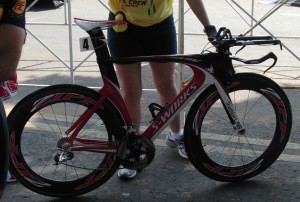
No behind-the-saddle hydration for Macca either- he ran a simple aerobar cage and down tube cage. I don’t get the round bottle on the down tube though. You ride a leading edge aero frame designed in the wind tunnel to be super slippery, then you mess the whole thing up with a big fat round bottle in the middle of the frame. Now I do recall that two frame-mounted round bottles can make a non-aero frame more aero, but in the case of a finely tuned aero frame, I can’t imagine it improves flow. I would think behind the saddle must be better if done right. Cervelo’s Phil White seemed to think so when we discussed this a couple years ago. Macca’s a smart guy and so is the Specialized crew so maybe they know something I don’t. Note the two Salt Stick dispensers in the aerobar extensions.
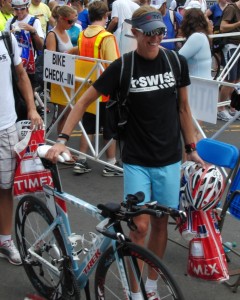
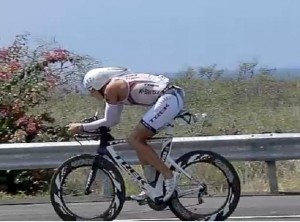
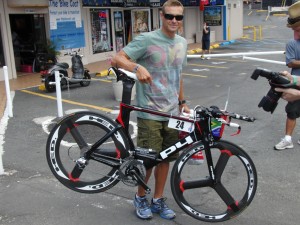
Tissink’s “Shiv4” – Raynard Shivmofied the front end of his P4 with a custom built, SA-themed hydration unit. The “Tissdrink” shrouds the P4’s conventional front brake much like the Shiv’s nosecone which was outlawed by the UCI. Timo Bracht tried something like this last year on his Giant, which already has a nose cone.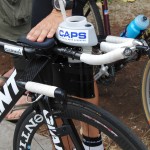
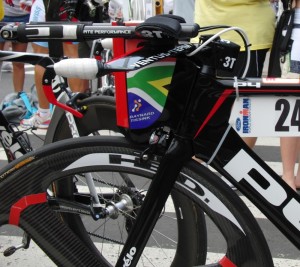
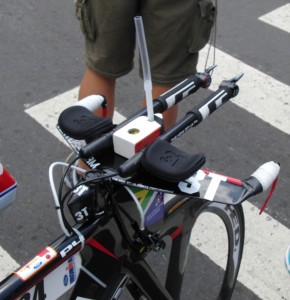
Big Sexy’s Wilier – Chris Macdonald’s front end setup reminds me very much of the one I used on my old P3 – closely-spaced Zipp Vuka clips and a Fuel Belt aero fuel box to fill the gap behind the steerer. With extensions this close together, it is easy to zip-tie a bottle cage between them. Chris solved the computer placement problem by slotting his Joule between the bar tips. This prevents wrapping his hands around each bar, but with close tips like this it lends itself more to a hand-over-hand grip anyway. One of the other perennial questions is where to stuff your spare tubular. I always hate having the thing hanging off the back of my seatpost or hydration unit, so here is one alternative – under the aerobars. Chris chose an ISM Breakaway saddle, complete with behind-the-saddle trucker hat mount!
Speaking of frame-mounted bottles, note the position of the cage on the Wilier’s down tube: it’s low and the bottle sits at a relatively flat angle. This will both reduce the frontal area of the bottle, and improve its aerodynamic shape. As you angle a cylinder more, the flow “sees” the cylinder as a more oblong cross section improving its drag coefficient. Since the WIlier was designed by John Cobb in the wind tunnel, I am certain this bottle placement was no accident.
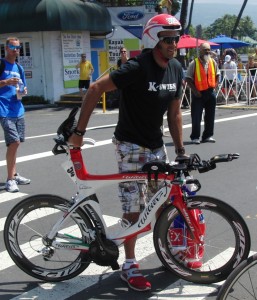
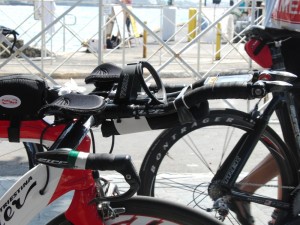
Look for part 2 coming soon!
